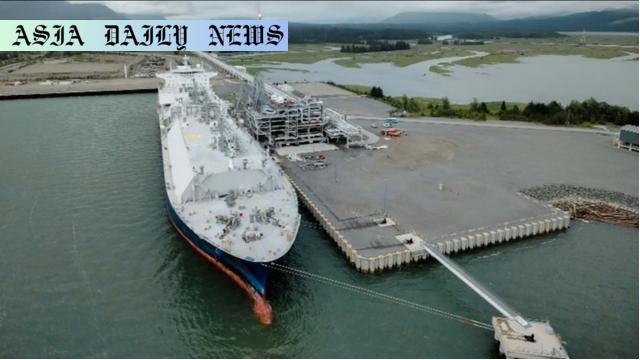LNG Canada begins operations with its first shipment to Asia, boosting energy flexibility and global competitiveness.
- LNG Canada ships its first LNG cargo from British Columbia to Asia.
- The project, led by Shell and Asian firms, enables energy flexibility.
- 2.1 million tons allocated to Japan’s Mitsubishi Corporation.
- Delivery takes under 10 days, faster than traditional oil imports.
- Japan diversifies its energy sources amid global supply disruptions.

Introduction: A Strategic Shift in Energy Supply
The LNG Canada project has set a historic milestone by shipping its first liquefied natural gas (LNG) cargo from British Columbia, Canada, to Asia. This achievement demonstrates not only Canada’s growing role as a reliable energy supplier but also represents a significant step forward in global energy trading. Led by British energy giant Shell and partners like Mitsubishi Corporation, the project produces 14 million tons of LNG annually. Of this total, around 2.1 million tons are allocated to Japan’s Mitsubishi Corporation, highlighting the strategic importance of this collaboration in meeting Asia’s growing energy demands.
The shipment’s departure comes at a time when Japan, one of the largest LNG importers in the world, is diversifying its energy sources to counter uncertainties caused by global geopolitical tensions. The 10-day shipping timeline between British Columbia and Japan positions LNG Canada as a faster alternative compared to traditional oil imports from regions like the Middle East and the U.S. This speed is an added advantage for energy-dependent countries like Japan, where climate goals and logistical considerations are increasingly pivotal.
Canada’s Role as a Global Energy Supplier
Canada has long been associated with its vast natural resources, but its emergence as a key LNG exporter marks a new chapter. The LNG Canada facility has the infrastructure to liquefy natural gas, making it portable and easier to export. This project adds a new dimension to Canada’s energy portfolio, offering a cleaner and more versatile energy source to its Asian partners. Furthermore, as energy markets respond to vulnerabilities like Russia’s invasion of Ukraine and other global conflicts, Canada’s ability to provide a stable and secure supply of LNG strengthens its position in global energy circles.
Japan stands to benefit significantly from this new energy partnership. As the world’s third-largest economy, Japan continues to rely heavily on imported energy resources. LNG offers Japan a sustainable alternative, producing lower carbon emissions than coal and oil. Mitsubishi Corporation Executive Vice President Saito Masaru aptly expressed the company’s optimism, emphasizing that Canada’s LNG supply would enable it to meet Japan’s increasing domestic requirements while fostering multi-bilateral ties.
Impact on Japan’s Energy Diversification Efforts
The timing of LNG Canada’s inaugural shipment is significant. Global energy markets are undergoing a transformation, with countries seeking to secure dependable and diverse sources of energy due to fluctuating geopolitical conditions. Recent disruptions caused by conflicts involving Russia and the Middle East have underscored the vulnerabilities in supply chains. Japan’s collaboration with Canada helps mitigate risks associated with supply instability while also reducing dependency on traditional suppliers.
This partnership also aligns with Japan’s pursuit of sustainability and its commitments under the Paris Agreement to decrease greenhouse gas emissions. Natural gas, while not entirely clean, serves as a transitional energy source in Japan’s broader efforts to adopt renewable energies. Furthermore, with shorter transport times, LNG shipments from Canada offer an economically viable and environmentally conscious alternative.
Future Implications of the LNG Canada Project
Looking ahead, the success of LNG Canada’s first shipment marks the beginning of a new era. With its substantial production capacity and state-of-the-art infrastructure, the project sets a benchmark for energy collaborations between North America and Asia. The reduced delivery timelines and increased reliability inject new momentum into international trade relationships. The integration of Canada into Asia’s LNG market broadens the horizons of energy geopolitics while encouraging investments in cleaner energy technology.
As demand for LNG continues to grow in Asia due to industrialization and urbanization, LNG Canada’s contributions will likely expand. Moreover, technological advancements in LNG processing and shipping could further reduce environmental impacts. The project also paves the way for other liquefied natural gas initiatives within Canada, potentially turning the country into a global petroleum powerhouse.



Commentary
Introduction: A Milestone Achievement in LNG Export
LNG Canada’s successful first shipment to Asia is an exciting milestone that exemplifies the potential of cross-border energy collaborations. At a time when global energy dynamics are turbulent, projects like this offer a ray of hope by emphasizing cooperation and innovation. It is particularly inspiring to see Canada emerge as a major player in the LNG market, further diversifying the global energy landscape.
The Strategic Importance of Canada’s Contribution
Canada’s contribution to the LNG market holds immense strategic value. Not only does it enable Japan to diversify its energy sources, but it also provides an economically viable and environmentally friendly alternative to oil. Faster delivery times compared to traditional routes signify the operational efficiency underpinning this initiative. Furthermore, this partnership has robust implications for strengthening Japan-Canada ties and boosting global energy security.
Broader Relevance and Lessons for the Future
The launch of LNG Canada’s operations serves as a reminder of the importance of shared global efforts in building a sustainable future. As climate change concerns gain urgency, innovative energy solutions like LNG take center stage in offering cleaner and practical alternatives. However, while LNG is a step in the right direction, integrating renewable energy infrastructure should remain on the agenda.
In conclusion, the LNG Canada project beautifully exemplifies what can be achieved through strategic investments, international cooperation, and technological ingenuity. It not only meets rising LNG demands but also serves as a blueprint for future energy projects worldwide. This landmark event reminds us that the energy industry must continue to evolve in response to global challenges while prioritizing sustainability and equitable energy access.